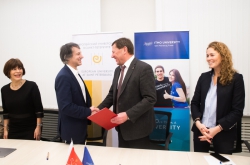The two-day course was organized by ITMO's Science Communication Center and Russian Venture Company's "Communications Laboratory" project with support from the GS Group holding. Its first day was dedicated to such theoretical aspects as the social background of the popular science phenomena; during the second day, the speakers focused on real cases showing the recent state of science communication in Russia.
Such experts as Elena Brandt, head of PR of the Moscow Institute of Physics and Technology and chief of operations officer of the Akson association, Irina Yakutenko, science journalist and founder of the "Russell's Teapot" agency, Ekaterina Tukel, head of GS Group holding company's press center, and Dmitry Malkov, head of ITMO's Science Communication Center, shared about how scientific press centers work and what will they do in the future, what's the use of science communication for business and scientists, and can "science communicator" be called a profession.
We've scaled the four hours of lectures down to seven topics.
So, is "science communicator" already a profession?
Yes, according to specific criteria, believes Elena Brandt. If we look at science communication in terms of the dictionary definition of profession, it is the result of the specialization of labor, it calls for special skills and training (as of now, they train science communicators not only in at the Imperial College London , but in other educational establishments as well, for instance, ITMO University), and it has to benefit society (at the very least, it translates scientific news to the general media). How else would most of the population learn about the hadron collider, nanotechnologies, machine learning and such? School programs just can't follow the most recent achievements in science and technology.

Unlike countries where science communication as a professional field has been around for a long time already, in Russia this field came about only several years ago — namely, in 2014. This was also when such popular resources as N+1, Schrodinger's Cat and the like got a second start, and new titles on popular science began to appear. In a way, this year was also the year when the first professional press centers appeared in Russia's leading scientific establishments — for instance, it was the time when such governmental enterprises as Rosatom, Roscosmos and Rosnano started to conduct active PR policies.
So who already works in this field in Russia?
Last year, the Akson Association in collaboration with the Russian Venture Company and ITMO University conducted a research on the state of the science communication field in Russia. To assess the extent of science communication in Russia and its dynamics in comparison with 2014, the research team has processed data on 1582 governmental research and educational institutions.
The specialists used such data as the proportion of organizations that have specialized departments for external communications, the names and types of the departments that deal with science communication, their overall efficiency and such. For instance, they used data on everything that has to do with openness and visibility — websites, presence in social networks, specialized mobile apps and even how easy it is to assess staff by phone.
Then, the team drafted a long list based on quantitative criteria, consisting of 169 organizations.
According to Ms. Brandt, the research showed that separation of the communications function into specialized units has become more widespread among Russian science and educational establishments. If three years ago, no more than a fourth of these establishments did it, in 2016 it was 40% for research institutes and 35% for universities.

What's the role of science communicators in universities and research institutes?
Every science communication unit has similar functions, even though they often have different names: most commonly, it is press centers or PR offices, or media centers. On average, such units have 5−10 personnel who communicate with the press, monitor the media, as well as maintain the establishment's website and its presence in social networks. By the way, the most popular social network among universities and research establishments is Facebook (more than 35% according to Akson's research). The popularity of specialized mobile apps is growing as well — such services are already used by 17% of the organizations from Akson's long-list.
Why don’t scientists engage in science communication themselves since they have the best knowledge of their subject?
Surely, some of them can, but they still can't do it as fast and effective as science communicators.
"If we're talking about communicating with the media, it is clear that it requires a) an understanding of how the media works and b) knowing the corresponding formats — i.e. understanding how, where and to whom one should pitch. One also has to know the so-called theory of mind — have the ability to look at things from another's viewpoint, especially for those don't know the background behind the research, and explain it in layman's terms. Not many scientists have such competencies, and I believe that they don't really need it. Lastly, all of this requires time. And that gets us back to specialization of labor", explains Elena Brandt.
According to Dmitry Malkov, head of ITMO's Science Communication Center, science communicators are really best at bringing science to a wide audience — even though many alternative science communication formats emerged. This way, the role of communications heads of scientific establishments becomes even more important: they are the link that makes communication a lot easier, and at the same time provides for its diversity.
What's the point of science communication from a scientist's point of view?
"There are a series of factors that can contribute to a scientist's motivation. Among the most essential ones are those that have to do with increasing the citation rate (there is research on that and the results are quite curious), academic reputation, opportunities for creating collaborations and finding new partners, and additional financing", explains Dmitry Malkov.

Yet, I still find it hard to believe that research showing the possible interrelation between using Twitter and one's Hirsch index will really motivate anybody, adds the head of ITMO's Science Communication Center.
"From my experience, the only way to motivate someone is to show a specific success story. For a PR specialist — someone who’s work is communicating with media — this can be some informational resonance which later led to particular results. For instance, after you've written a press release and it got into tens of different media, the scientist gets many collaboration offers and even letters from investors. This is a real story, and we actually found investors. Later, one of them noted in his expert analysis that when searching on the subject they found a great number of publications in Russian and international media, which showed the project team's competency", shares Dmitry Malkov.
By the way, in foreign business practice this business model is firmly embedded: how else can one get the financial support of taxpayers, or stakeholders, if not by publicly reporting the results of one's research? This is the way NASA and CERN operate, and we can read about their accomplishments every month.
Do businesses have any need for science communication?
As daily practice shows — yes. According to Ekaterina Tukel, head of the GS Group holding’s press center, science communication has become one of its missions.

"We organize tours to our plants, launch educational programs, develop communications with the media. As for the latter, we face many problems, especially in the regions: no one wants to really explain what we do. That is why we are planning a special project for the Kaliningrad region, where our specialists will explain what radioelectronics is, what multi-wall nanotubes are, and the like, — shares Ms. Tukel. We do PR in a good sense — we promote our colleagues, the scientists. Why do we need it? For people to understand that one can do something really cool in this field, for them to want to go to our Technopolis, to the regions, where science is, that its comfortable, interesting and profitable".
What is science communication’s future? And is the society ready to pay for popular science?
As of today, popular science is represented in different fields — be it sciential media (journals, Internet, TV programs) and publics in social networks, or different science-slams, museums, festivals and projects for children. But what will become of this abundance, what will go and what will stay, and are people ready to pay for it?
According to Irina Yakutenko, science journalist and founder of the "Russell's Teapot" agency, the lifespan of free and even freemium projects is very limited and fully depends on the volunteers. This is why free "lectoriums" or science festivals are to make way for more professional events. On the other hand, people don't like paying for "pure" popular science, and the situation doesn't seem to change, so all of its forms will have to meet the several "usefulness" criteria: the speakers will have to be more competent and renowned, and successful projects will be seen as a way of getting supplementary education.

"Independent projects are limited by the time the volunteers stay with them. Free "lectoriums" will appear and fade away, as they work for only as long as there's enthusiasm. Then, they become commercial, or die. There will be more and more professional lectures, as well as popular science agencies that will professionally organize festivals. As of now, there are many science events and festivals, but those are mostly amateur and are organized poorly".
In time, there will even be schools for lecturers and science communicators. The tendency is already here and will develop more and more in the future, concluded Irina Yakutenko.






